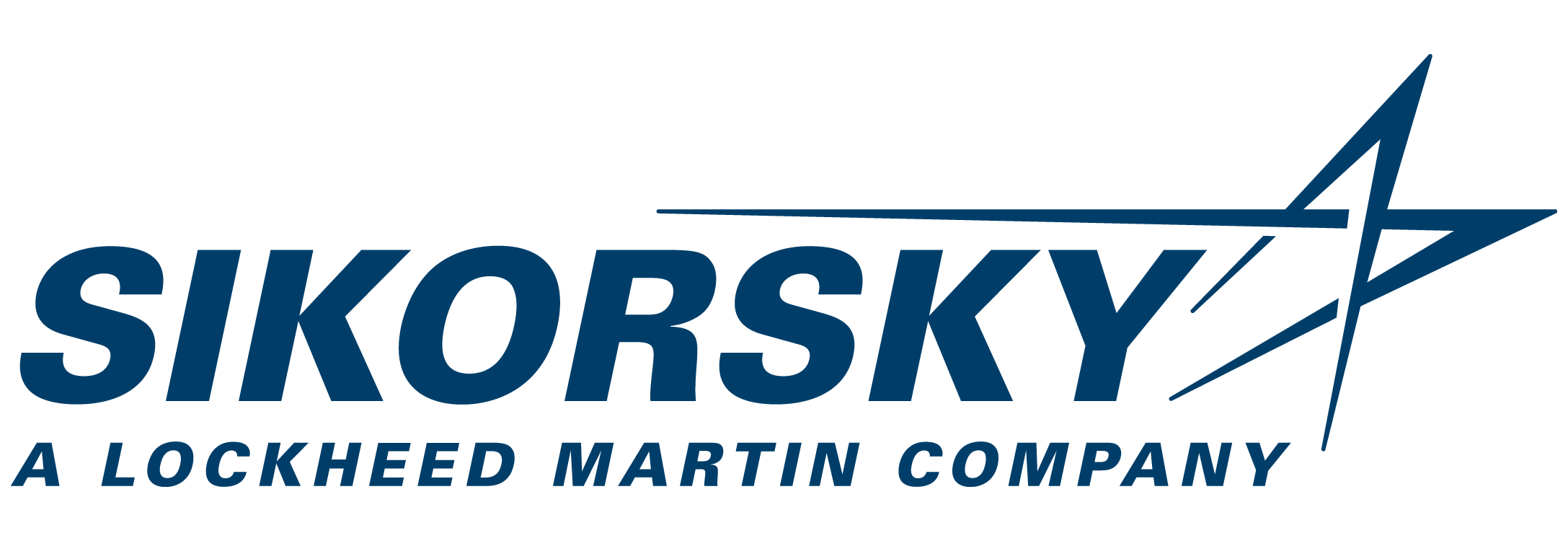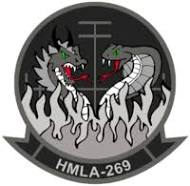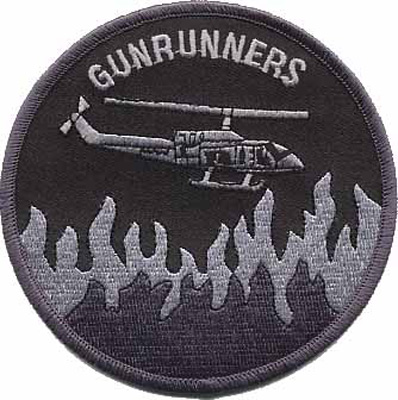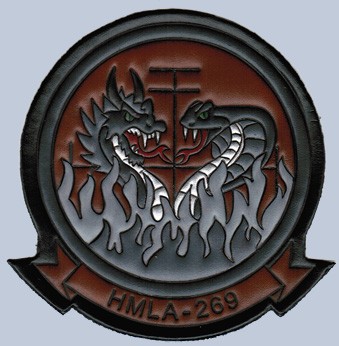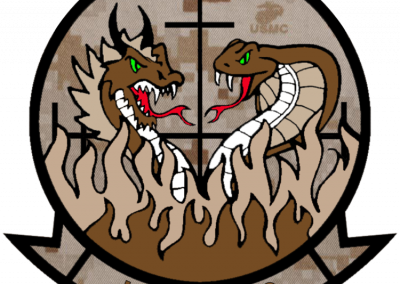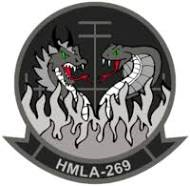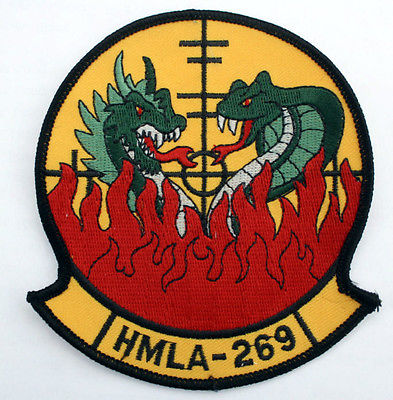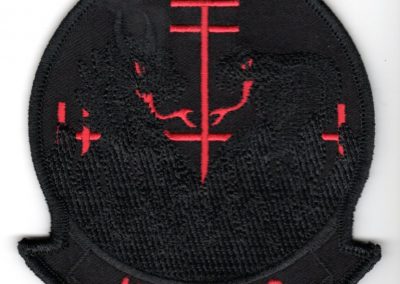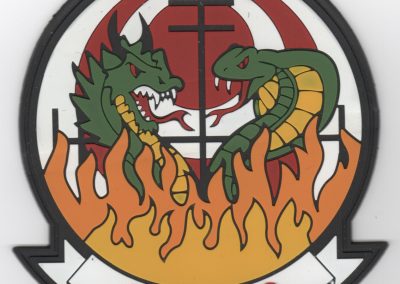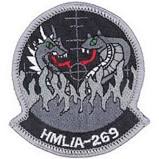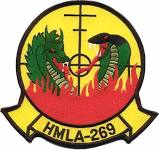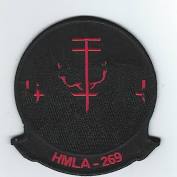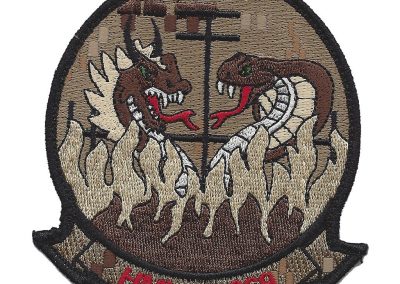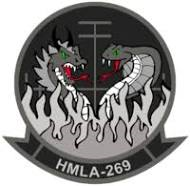
HMLA-269 Squadron Patch
History of HMLA-269
HMLA-269 was formed at Marine Corps Air Station New River, North Carolina on 22 February 1971 and activated on 1 July 1971 as the Marine Corps first designated Attack Helicopter squadron. Equipped with the AH-1J Sea Cobra, HMA-269s mission was to provide close-in fire support during aerial and ground escort operations during ship to shore movement and subsequent operations ashore.
In December 1977 HMA-269 took delivery of the first AH-1T (TOW) Cobra. The Squadron opened a new era of attack helicopter aviation in 1979 by being the first Marine Corps squadron to fire the TOW anti-tank missile from an airborne platform. From that day, HML/A-269 has not surrendered the lead in developing a wide range of new anti-armor tactics. In the Early Eighties, with the addition of the UH-1N, HML/A-269 expanded its primary mission to include utility helicopter support. Though heavily committed, HML/A-269 maintained its impressive list of firsts; first flight testing of biochemical protective suits in the AH-1T (TOW), first flight testing of fast rope insertion equipment, first to refine the TOW missile engagement gun and missile radars. Additionally, the squadron participated in the first actual movement of 2d Marine Aircraft Wing assets in an air contingency drill. In 1986, the Gunrunners achieved yet another first when they fired a Sidewinder air-to-air missile at a target drone over the Desert of China Lake. These achievements earned the squadron a Meritorious Unit Commendation and selection as the Marine Corps Helicopter Squadron of the Year for 1986.
In 1990, the Gunrunners deployed to Southwest Asia with twelve AH-1Ws, three AH-1Ts and six UH-1Ns. These assets participated in major 4th Marine Expeditionary Brigade exercises during Operation DESERT SHIELD. During operation DESERT STORM, the squadron conducted critical on-call close-in fire support, escort for minesweeping aircraft, Surface Combat Air Patrol, and air intercept operations. Meanwhile, Gunrunner Hueys played a vital role in the raid on Faylaka Island, firing in excess of seventy-five 2.75 rockets at fortified Iraqi positions under NVG low light level conditions.
Following the Gulf War, the Gunrunners continued to support requirements of LF6F deployments, in such areas as Yugoslavia, Somalia and the Middle East. The squadron also supported numerous 2d Marine Aircraft Wing and Marine Forces Atlantic exercises, both CONUS and abroad, including exercises in Norway and Puerto Rico. In 1994 the Gunrunners were tasked with providing a detachment on short notice to HMM-264 for Special Purpose MAGTF-CARIB in support of Operation UPHOLD/SUPPORT DEMOCRACY in Haiti. One year later, on June 1995, two Gunrunner Cobras, assigned to HMM-263 escorted two CH-53Es from the USS Kearsage to successfully rescue Air Force Captain Scott OGrady. During this deployment, HML/A-269 also became the first squadron to deploy the new Night Targeting System on all of its Cobras; effectively adding increased combat compatibility to the forward deployed forces. Being Named the HML/A-269 Squadron of the Year rewarded the squadrons hard efforts that year.
The squadron also supported detachments with LF6F deployments that supported Operation ASSURED RESPONSE in Liberia. In 1997 the HML/A detachment to HMM-365 supported Operation SILVER WAKE in Albania and Operation GUARDIAN RETRIEVAL in the Congo.
In recognition of its hard-earned reputation for setting the standard in attack helicopter aviation, the Gunrunners were designated the Marine Light/Attack Helicopter Squadron of the Year in 1998 by the Marine Corps Aviation Association.
In the wake of the events on September 11, 2001, the Gunrunners attached to HMM-365 (REIN) with 26th MEU (SOC) flew combat missions in support of Operation ENDURING FREEDOM (OEF) from forward operating Bases Rhino and Kandahar, in Afghanistan. In 2002 the Gunrunners attached to HMM-263 (REIN) with the 24th MEU (SOC) flying in Kosovo, the Horn of Africa, OEF and OIF. In January of 2003, the Gunrunners deployed as a squadron in support of OIF) HML/A-269 flew nearly 3000 combat hours in 55 days and maintained 24-hour operations with no personnel losses due to enemy action or mishaps. Bottom line, Gunrunners delivered deadly fire on enemy positions protecting our Marines as they pressed towards Baghdad.
The Gunrunners continued to deploy to Iraq over the following years. They deployed in support of OIF during 2005, 2006, and 2007. During 2005 the Gunrunners flew more than 5951 hours and 3994 sorties, in 2006 they flew over 5452 hours and 4025 sorties, and in 2007 the Gunrunners flew over 4791 hours and 3478 sorties. Between each deployment the squadrons Marines were home for a period of only 5 months before once again joining the fight.
In August 2008 after a year home, the Gunrunners deployed to both Iraq and Afghanistan in support of OIF and OEF. The Gunrunners main body resided in Al Asad Iraq and their detachment of 4 AH-1Ws and 51 personnel were sent to Camp Bastion, Afghanistan. In December of 2008 HML/A-269s main body was called upon to make a difficult intra-theater movement to Al Taqaddum, Iraq. The Gunrunners were tasked with conducting their cross country movement while maintaining uninterrupted combat operations. The Gunrunners rose to the occasion and pulled off the move with nonstop combat support. OIF and OEF combined, the Gunrunners flew over 3800 hours and 3294 sorties. During this deployment the Gunrunners adopted their infamous deployment call sign Lawman and the use the Lawman Star.
Once again, after only a 5 month turnaround, the Gunrunners were called upon for another deployment to Iraq. In August of 2009 the squadron departed for Iraq in support of OIF where they maintained dual site operations at Al Asad and Al Taqqadum. In December 2009 the Gunrunners left Iraq as the last Marine Corps attack aircraft to be stationed in Iraq in support of OIF. While deployed the squadron flew 1821 combat hours in support of 1963 sorties. Shortly After the squadrons return to New River they were announced as the recipients of the Marine Corps Aviation Associations HML/A of the year award for 2009.
Gunrunner Marines have continually set the standard for professionalism, innovation, and mission accomplishment. They have led the way in the Light/Attack Helicopter community. Aggressive training, a pioneering spirit, and inspired leadership have molded HML/A-269 into the tactically minded and combat-ready fighting unit that it is today.
With over a year of much deserved rest at home, the squadron re-deployed in May 2011 to Afghanistan in support of OEF. Here they would record the first Hellfire shot from a Cobra with an RQ-7 UAV designating. The Gunrunners returned home in early 2012 to begin preparing for training in El Centro, CA where they would shoot the last TOW missile from an HMLA aircraft. 2012 was another groundbreaking year for the Gunrunners; holding the sundown event for the last squadron flight of the UH-1N, while also operating as a quad-sited squadron, supporting the 24th and 31st MEUs, OEF, and operations at MCAS New River simultaneously. For their dedication and hard work, the Gunrunners were awarded the John P. Giguere Marine Light Attack Helicopter Squadron of the Year 2013 Award. HMLA-269 continued to support the MEU rotation and re-integrated the 22nd MEU after a seventeen- month mission detachment with VMM-263 (REIN) from 2013 through the end of 2014.
HMLA-269 began 2015 with initial Digital Interoperability (DI) training, a capability that allows multiple cockpits and friendly forces on the ground to join the same network on handheld devices, greatly enhancing the situational awareness of everyone involved. While DI training took place stateside, the Gunrunner family detached Marines in support of the 24th MEU and Unit Deployment Program (UDP) 15-2. During UDP 15-2 the squadron supported Aviation Assault Support Exercise (AASE) and Bilateral Tactical Exercise (BiTACEX) 15.2 in the Philippines. This detachment integrated day and night flights with academic training alongside Philippine Air Force (PAF) personnel, representing several firsts. HMLA-269 also took part in Operation Blue Chromite, during which Gunrunner aircraft participated in validating the VMM Spider FARP concept, conducting both refueling and rearming operations at an expeditionary site. By the end of UDP, HMLA-269 received a Bravo Zulu from the Commanding Officer of MAG-31 for both operational excellence and unprecedented aircraft readiness. For their dedication to professionalism and can-do spirit, the Marine Corps Aviation Association awarded HMLA-269 the John P. Giguere Award for Marine Light Attack Helicopter Squadron of the Year 2016 Award.
In 2016, the Gunrunners of HMLA-269 continued to demonstrate their tireless devotion to mission accomplishment while simultaneously operating in as many as five separate locations world-wide. These locations include supporting Operation ODYSSEY LIGHTNING (OOL) with the 22nd MEU, WTI courses 2-16 and 1-17, Integrated Training Exercise 3-16, the 24th and 31st MEU, and maintaining an operational squadron (-)(-) supporting II MEF at home. The 22nd MEU was directed to the Gulf of Sidra in support of OOL near the city of Sirte, Libya. OOL supported U.S. Special Operations Forces which enabled the Government of National Accord (GNA) to liberate the city of Sirte from the Islamic State of Iraq and the Levant – Libya (ISIL-L). In May, HMLA-269 deployed a detachment to the 31st MEU who would soon conduct three operational exercises while afloat, in the vicinity of Guam, Philippines, and Okinawa. In August, the squadron supported a third detachment to the 24th MEU and with the squadron stretched thin, a fourth detachment supported Weapons and Tactics Instructor Course (WTI) 1-17 in September. The WTI detachment became the fourth element of HMLA-269 to simultaneously operate away from the flag, making HMLA-269 a five-sited squadron.
